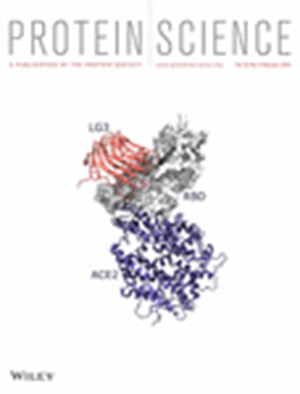人类赖氨酰羟化酶 JMJD7 的底物选择性和抑制作用
IF 4.5
3区 生物学
Q1 BIOCHEMISTRY & MOLECULAR BIOLOGY
引用次数: 0
摘要
含 Jumonji-C(JmjC)结构域的蛋白 7(JMJD7)是一种人类铁(II)和 2-氧代戊二酸依赖性加氧酶,它能催化发育调控 GTP 结合蛋白 1 和 2(DRG1/2)中赖氨酸的立体特异性 C3-羟基化。我们报告了对纳入 DRG1 肽的各种赖氨酸衍生物作为潜在人类 JMJD7 底物和抑制剂的探索研究。研究结果表明,与其他一些 JmjC 羟化酶和赖氨酸修饰酶相比,人类 JMJD7 的底物范围相对较窄,仅包括赖氨酸。在 JMJD7 催化的 C3-羟基化过程中,受几何限制的 (E)-dehydrolysine 是赖氨酸的有效替代物。γ-硫赖氨酸和γ-氮丙氨酸进行 C3-羟化,然后降解为甲酰基甘氨酸。JMJD7 还能催化 DRG1 衍生的肽的 S-氧化,这些肽具有代替赖氨酸的蛋氨酸和同蛋氨酸残基。抑制试验表明,具有半胱氨酸/半胱氨酸而非赖氨酸残基的 DRG1 变体可通过交联作用有效抑制 JMJD7。总体结果为人类 JMJD7 的底物选择性和抑制作用提供了信息,有助于合理设计 JMJD7 的选择性小分子和拟肽抑制剂。本文章由计算机程序翻译,如有差异,请以英文原文为准。
Substrate selectivity and inhibition of the human lysyl hydroxylase JMJD7
Jumonji‐C (JmjC) domain‐containing protein 7 (JMJD7) is a human Fe(II) and 2‐oxoglutarate dependent oxygenase that catalyzes stereospecific C3‐hydroxylation of lysyl‐residues in developmentally regulated GTP binding proteins 1 and 2 (DRG1/2). We report studies exploring a diverse set of lysine derivatives incorporated into the DRG1 peptides as potential human JMJD7 substrates and inhibitors. The results indicate that human JMJD7 has a relatively narrow substrate scope beyond lysine compared to some other JmjC hydroxylases and lysine‐modifying enzymes. The geometrically constrained (E )‐dehydrolysine is an efficient alternative to lysine for JMJD7‐catalyzed C3‐hydroxylation. γ‐Thialysine and γ‐azalysine undergo C3‐hydroxylation, followed by degradation to formylglycine. JMJD7 also catalyzes the S‐oxidation of DRG1‐derived peptides possessing methionine and homomethionine residues in place of lysine. Inhibition assays show that DRG1 variants possessing cysteine/selenocysteine instead of the lysine residue efficiently inhibit JMJD7 via cross‐linking. The overall results inform on the substrate selectivity and inhibition of human JMJD7, which will help enable the rational design of selective small‐molecule and peptidomimetic inhibitors of JMJD7.
求助全文
通过发布文献求助,成功后即可免费获取论文全文。
去求助
来源期刊

Protein Science
生物-生化与分子生物学
CiteScore
12.40
自引率
1.20%
发文量
246
审稿时长
1 months
期刊介绍:
Protein Science, the flagship journal of The Protein Society, is a publication that focuses on advancing fundamental knowledge in the field of protein molecules. The journal welcomes original reports and review articles that contribute to our understanding of protein function, structure, folding, design, and evolution.
Additionally, Protein Science encourages papers that explore the applications of protein science in various areas such as therapeutics, protein-based biomaterials, bionanotechnology, synthetic biology, and bioelectronics.
The journal accepts manuscript submissions in any suitable format for review, with the requirement of converting the manuscript to journal-style format only upon acceptance for publication.
Protein Science is indexed and abstracted in numerous databases, including the Agricultural & Environmental Science Database (ProQuest), Biological Science Database (ProQuest), CAS: Chemical Abstracts Service (ACS), Embase (Elsevier), Health & Medical Collection (ProQuest), Health Research Premium Collection (ProQuest), Materials Science & Engineering Database (ProQuest), MEDLINE/PubMed (NLM), Natural Science Collection (ProQuest), and SciTech Premium Collection (ProQuest).
 求助内容:
求助内容: 应助结果提醒方式:
应助结果提醒方式:


